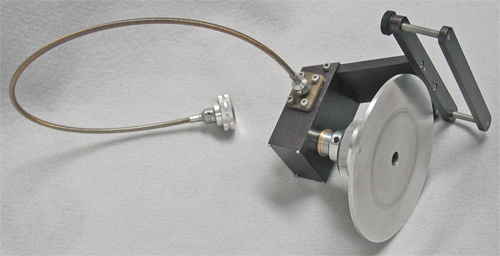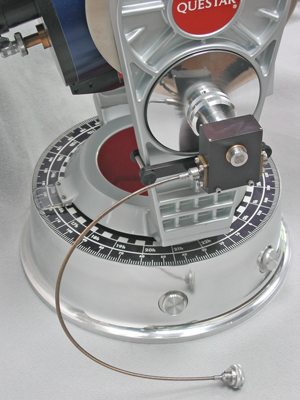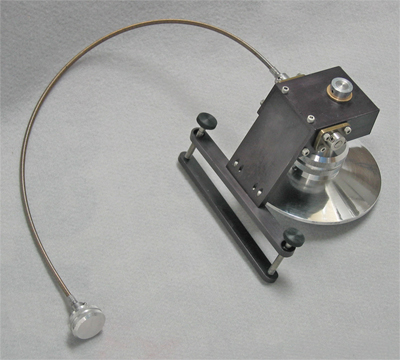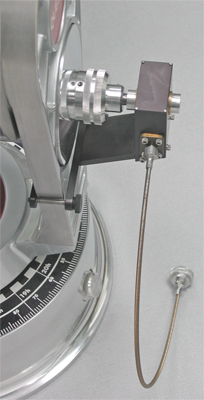Questar Distribution
![]() News
News ![]() Notes & Interesting Articles
Notes & Interesting Articles ![]() Overview
Overview ![]() Pricing
Pricing ![]() Products
Products ![]() Service or Repair
Service or Repair
Questar Telescopes ![]() LD Surveillance Systems
LD Surveillance Systems ![]() LD Microscopes
LD Microscopes ![]() Accessories
Accessories


QUESTAR SEVEN FORK DECLINATION VERNIER MANUAL DRIVE
This accessory made by Questar for the Questar 7 Fork was discontinued in the mid 1980's, since replaced by motorized models.This article is provided as a courtesy by Company Seven for those customers who have helped to keep us in business.
 Preface: Company Seven is a resource for the international astronomical, nature watching and law enforcement/defense communities. We are the only Questar agent for their Consumer, and Industrial (Surveillance and Long Distance Microscope and Remote Measurement Systems) product lines. We are proud to present Questars for research, education and recreation to government, industry, and the most demanding amateur. The National Aeronautics & Space Administration (to whom we supplied Schmidt-Camera telescopes for the International Halley Watch), the U.S. Naval Observatory, the Smithsonian Institution, and the more demanding amateur astronomer and naturalist are our most prominent references.
Preface: Company Seven is a resource for the international astronomical, nature watching and law enforcement/defense communities. We are the only Questar agent for their Consumer, and Industrial (Surveillance and Long Distance Microscope and Remote Measurement Systems) product lines. We are proud to present Questars for research, education and recreation to government, industry, and the most demanding amateur. The National Aeronautics & Space Administration (to whom we supplied Schmidt-Camera telescopes for the International Halley Watch), the U.S. Naval Observatory, the Smithsonian Institution, and the more demanding amateur astronomer and naturalist are our most prominent references.
Above page title: Logo used by Questar from 1962 through 1960's.
Right: Declination Vernier Manual Drive for the Questar Seven telescope Fork Mount (89,086 bytes). Note the flexible cable and hand knob, the Gear Reduction Box, and the Bracket assembly that permits one to clamp the assembly onto the Fork Side Arm. The machined aluminum knob was put in place of the original Hand Knob, and this could be left in place for use with or without the Vernier Manual Drive Assembly.
The Declination Vernier Manual Drive shown here was among the accessories delivered new with the Questar Seven S/N P-7-378-DP when it was originally sold in 1979. The system is now in the Company Seven museum collection.
Click image to see enlarged view (188,542 bytes).
- Interfacing Declination Hand Knob to replace that originally provided with the Fork
- Support Frame with two hand knobs to install and support the Gearbox alongside the Fork Tine
- Gear reduction and right angle drive assembly
- Flexible control cable with hand knob.
 Introduction: The Questar 3-1/2 telescopes have been in production since 1954 with some changes over the decades, while the first Questar Seven S/N Serial No. P-7-1 was introduced in the Spring of 1967. As the Earth rotates along its axis, objects in the sky appear to move in an arc rising on one horizon, climbing into the sky then descending and setting on the opposite horizon. Fork and German style equatorial mounts were developed so that telescopes could compensating for the Earth's rotation by moving in the exact opposite direction and same apparent speed as the Earth rotates and this keeps objects in the field of view providing convenience. By the 1960's astrophotography was becoming more and more possible to the amateur with the advancement of film technologies and new specialized accessories (Off Axis Guider, etc.). To provide the new Questar Seven with these capabilities, Questar Corp. scaled the Questar 3-1/2 fork mount arrangement to suit the more massive Questar Seven; the result is magnificent to behold - a blending of 20th century practicality and uncommon craftsmanship.
Introduction: The Questar 3-1/2 telescopes have been in production since 1954 with some changes over the decades, while the first Questar Seven S/N Serial No. P-7-1 was introduced in the Spring of 1967. As the Earth rotates along its axis, objects in the sky appear to move in an arc rising on one horizon, climbing into the sky then descending and setting on the opposite horizon. Fork and German style equatorial mounts were developed so that telescopes could compensating for the Earth's rotation by moving in the exact opposite direction and same apparent speed as the Earth rotates and this keeps objects in the field of view providing convenience. By the 1960's astrophotography was becoming more and more possible to the amateur with the advancement of film technologies and new specialized accessories (Off Axis Guider, etc.). To provide the new Questar Seven with these capabilities, Questar Corp. scaled the Questar 3-1/2 fork mount arrangement to suit the more massive Questar Seven; the result is magnificent to behold - a blending of 20th century practicality and uncommon craftsmanship.
Right: Questar Manual Declination Control shown installed on a Questar Seven Fork. Notice one of the two long bolts that span the Fork Tine and hold the Support Frame in place (59,000 bytes).
Click image to see enlarged view (238,991 bytes).
The Standard and Duplex models are furnished with a motorized fork style drive base. While buyers of their larger cousin the Questar Seven are provided with the choice of the Questar Seven Fork Base or third party German Equatorial mounts. Each Questar fork is provided with a set of three lightweight alloy legs to form a tripod that is adjustable for latitude. Two of the legs are made to thread into the drive base at two points on the side, and a Pole Axis leg threaded into the bottom of the cast aluminum base. This tripod arrangement permits Pole Alignment of the mount by extending the Pole Axis leg, and the mount with the telescope may be operated on a table top. The Fork is provided with a manual control knob for turning the telescope left to right on the Fork Base, this is referred to as Right Ascension since in the Northern Hemisphere the motion appears to follow rising objects in a clockwise and ascending motion. The Fork also incorporates a manually geared control for elevation, referred to as Declination since this controls how high in the North or down into the Southern hemispheres the telescope is pointed.
The Fork Base was initially furnished with a choice of either a 120 or 220 volt AC motor and power cord. When plugged in the motor turns at a rate of about one revolution per 24 hours allowing the telescope to track objects across the sky. When ordering the Questar Fork and Base drive system the customer would either specify their preference for North or South Hemisphere, or from the 1980's on buy the Questar Powerguide 9 volt based drive system which can operate in either hemisphere. The drive system also moves the Right Ascension Setting Circle making it and the provided fixed Declination Setting Circle useful aids for navigating the night sky.
 The Declination Vernier Manual Drive: The manual gearing provided on all Questar Forks is useful for making adjustments of the telescope up or down, and left or right to center it onto one target or another. However, for astrophotographic applications or in some other instances it becomes necessary to be able to make very fine adjustments - so fine as to be visually imperceptible unless one is looking through the telescope. The fine control of the Right Ascension axis (faster or slower) was provided by means of the optional original Powerguide AC or DC powered drive corrector, and later by the Powerguide 9 volt systems. The Powerguide is a drive corrector that allows the user to operate the telescope in the field off 12 volt DC power or from AC power, and with it the user can vary rotation speed of the synchronous motor faster or slower. However, the original Powerguide made no provision for a motor to control Declination (elevation) and so in order to make fine adjustments possible in Declination Questar devised a precisely made gear reduction device named the Declination Vernier Manual Drive.
The Declination Vernier Manual Drive: The manual gearing provided on all Questar Forks is useful for making adjustments of the telescope up or down, and left or right to center it onto one target or another. However, for astrophotographic applications or in some other instances it becomes necessary to be able to make very fine adjustments - so fine as to be visually imperceptible unless one is looking through the telescope. The fine control of the Right Ascension axis (faster or slower) was provided by means of the optional original Powerguide AC or DC powered drive corrector, and later by the Powerguide 9 volt systems. The Powerguide is a drive corrector that allows the user to operate the telescope in the field off 12 volt DC power or from AC power, and with it the user can vary rotation speed of the synchronous motor faster or slower. However, the original Powerguide made no provision for a motor to control Declination (elevation) and so in order to make fine adjustments possible in Declination Questar devised a precisely made gear reduction device named the Declination Vernier Manual Drive.
The Declination Vernier Manual Drive restored by Company Seven and shown in this article was originally sold in February 1979 for $187.50 when the Questar Seven optical tube assembly sold for $2,970; yes this was a long time ago.
The Declination Vernier Manual Drive consists of several components:
With the introduction of the optional electronic Powerguide and Powerguide II drive systems starting in the mid 1980's, the drive base may operate from a common alkaline 9 Volt D.C. battery. A drive corrector circuit with hand control paddle permit functions including the selection of drive rate (Lunar, or Sidereal), and fine speed correction changes of +-1.4 or 10X. All control is done with "On Off" switch, and four (E-W-N-S-) buttons. There are no switches on the drive base - all is on the hand paddle that plugs into the bottom of the base. An internal Quartz reference circuit continuously checks motor speed (every 0.6 Arc Sec.) and adjusts it if necessary. But the most important aspects of this option are that it frees a person to travel around the world, to the North or South Hemisphere independent of external power supplies.
The development of the 9 volt Powerguide systems was accompanied by the introduction of an optional Motorized Declination Drive for the Questar Seven Fork. This accessory is attached onto the Fork Tine in a manner similar to that of the Declination Vernier Manual Drive, but in place of a gear box is a motor. One Motorized Declination Assembly was made for the original Powerguide, and over time this was discontinued while another (P/N 29526) is offered for the Powerguide II system.
The Questar Seven with Fork Mount is already a comparatively rare telescope, and those who attempted astrophotography with the degree of professionalism that demanded the optional Declination Vernier Manual Drive were even fewer. And so this is among the rarer accessories made by Questar. It arrived at Company Seven in February 1988 among the accessories included with the Questar Seven S/N P-7-378-DP made in 1979. It is among the items conserved by Company Seven and shown alongside P-7-378-DP in our museum showroom collection.
 Declination Vernier Manual Drive Specifications
Declination Vernier Manual Drive Specifications
| Gear Reduction Ratio | 30:1 |
| Geared Effect | 30 turns of hand knob = one complete rotation of Fork Knob |
| Geared Effect (Degrees) | 1 turns of hand knob = 12 degree rotation of Fork Knob |
| Weight (complete set) | 25.6 oz. / 727 Gr. |
| Extension from Fork Tine (installed) | 3.44 inches / 87.5 mm |
Right: Questar Manual Declination Control for the Questar Seven telescope Fork Mount (89,086 bytes).
We invite you to visit our showroom near Washington, D.C. to see a Questar first hand. Or contact us by E-mail to info@company7.com, or by telephone at 301-953-2000. The showroom is open Monday to Friday 11 am to 6 pm, Saturday 11 am to 5 pm. We are closed on Sundays, on U.S. Holidays, and from 25 December through 1 January inclusive.
Contents Copyright 1994-2006 Company Seven All Rights Reserved

